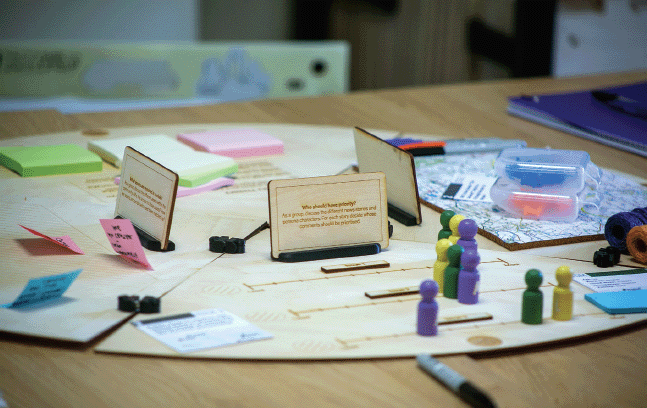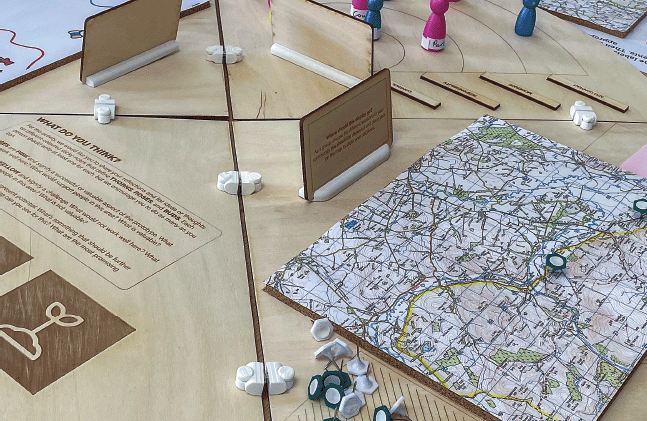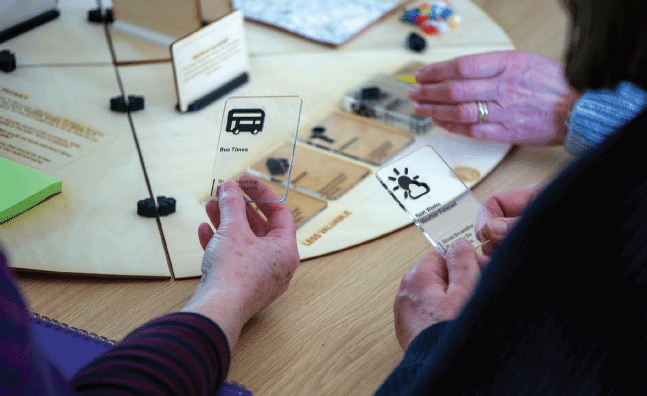Authors:
Ian G. Johnson, Vasilis Vlachokyriakos
Many civic technologies within HCI, despite having various ambitions and purposes, fail in similar and predictable ways. In this article, we posit that the fundamental pathologies that have held back or obstructed digital civics studies are inherent in the way participatory and grassroots approaches are adopted by digital civics researchers. Specific aspects of the designer's or researcher's expertise and experience are often put aside in the pursuit of a (participatory/user-centered/co)-design that is diligent in its avoidance of technodeterminism and other forms of top-down-ism to the detriment of applying learning from lived experience.
Outside of civic technology design, "probes" have allowed design researchers to promote (and provoke) responses from research participants, understand situated knowledge, and sensitize designers to local cultures through the elicitation of "inspirational data" that stimulates the imaginations of the designers without constraining designs or directing designers [1].
→ Civic technology research underutilizes breakdowns as learning points.
→ The civic probe concept diverges from HCI probes, inquiring into civic infrastructure and prioritizing the collective over personal or family considerations.
→ The civic probe we designed embedded questions about governance, accountability, situatedness, the value and timeliness of information and data, and the sustainability or resilience of infrastructures.
Probe is a term from medical science that refers to the process and means by which one finds out about the unknown. A probe can refer to a tool used to examine someone internally or a device put inside someone to test or record information. It can also refer to an attempt to discover information by asking questions—often to discover information someone is trying to obfuscate or conceal.
Probes within HCI are a means by which designers give something of themselves, sharing ideas and concepts in ways that encourage completion or presenting something partially made in ways that explicitly await closure, while limiting the form of the response [2]. Often the goal of probes is to inspire users and researchers to think about, for example, new technologies [3].
Our civic probe approach starts from the assumption that the problems in civic technology deployments are all too often there at the start, and that if they are not made visible to all stakeholders at that time, it will be detrimental to the social impact of designs and the relative success of an intervention. As such, the civic probe shares ideas (and asks questions) of research partners and collaborators about things that typically go wrong and attempts to inspire both research partners and researchers to think about not just the what of sociotechnical designs but also the how, the who, the when, and the where. It is an attempt to introduce critical questions and skepticism early in the project while eliciting data that is both inspirational and pragmatic, reflective and practical.
Since the genesis of the cultural probe in HCI, there has been a steady flow of probe-type studies, with various interpretations presenting divergences of the probe appended with, for example, empathy, urban, mobile, evaluation, medium, memory, and so on. This has led to reviews of the state of play of probes within HCI as "a ubiquitous neologism for design-led approaches to research" [4] that lack an orthodoxy in approach and pay homage to the stated values and experimental, artistic, and subversive nature of the archetypal probe [4,5]. Not all probes are equal, however, and some such divergences have more prominence and influence within HCI discourse.
The civic probe shares ideas (and asks questions) of research partners and collaborators about things that typically go wrong.
For example, design probes describe a particular flavor of cultural probe that emphasizes probes as tools for design and understanding in a more embodied way that prioritizes an ongoing relationship [2]. This was perhaps a term coined to put design at the heart of probe methods, in response to a move away from an off-the-shelf mentality that decenters design as the focus of probes. Specifically, design probes are "objects that are usually small in scale, whose materiality and form are designed to relate specifically to a particular question and context, posing a question through gentle, provocative, creative means offering a participant [an] intriguing way to consider a question and form a response through the act of completing the probe creatively" [2].
Whereas cultural probes as conceived by Bill Gaver et al. are materials that, while promoting reflection, act as a means to record and collect information that leads to designs detached from the probes, design probes are designed digital objects that "spur and support reflection," remaining with an individual throughout, "deliberately and specifically pointed towards the phenomena" [2]. In other words, design probes are a half-idea—a tentative hypotheses or future design idea.
Like cultural probes, technology probes are designed to introduce people to ideas but are configured to be lived with. As a point of difference, Hilary Hutchinson et al. write that "cultural probes tend to involve a single activity at a particular time and are not necessarily technologies themselves" [3]. Specifically, they have three goals: "the social science goal of understanding the needs and desires of users in a real-world setting, the engineering goal of field-testing the technology, and the design goal of inspiring users and researchers to think about new technologies" [3]. A point of differentiation from technology probes is the crafted element. Cultural probes are not professionally finished by design but do hint at what to expect from a final design. In a study of the way design researchers interpret probes, Sena Çerçi, Marta Cecchinato, and John Vines [4] found that the term probe can be resisted as well as evoke interest; it is tied up in ideas of legitimacy (and lack thereof) and acts as a shortcut—a way to anchor work in relation to others.
Departing from such a semiotic base, the civic probe anchors our work in relation to previous civic technology scholarship, as such acting as a shortcut through what might be considered the traditional phases of a digital civics study. This is similar to the technology probes discussed by Hutchinson et al. [3], where the idea was to enable families to affect the design of technologies for their homes more directly (as a departure from the traditional interview-design-test process).
In turn, this affords opportunities for us to start from the things that go wrong and focus on the things that are required to make them go right. Here, as with cultural probes, we bring our own experience and ideas about digital civic design, not being led by participants, and establishing opportunities for more focused yet ambiguous and dialogic engagement in the human, social, and information infrastructures entangled in civic technologies.
In this case, we have a body of work that takes the ideas (if not ideals) of probes in design-focused HCI work that act in different ways as a conduit between researchers/designers and participants: to convey ideas; establish working dynamics; break down, expose, or transform power relations; inspire; provoke; confuse; and encourage. Within this work we cautiously introduce the idea of the civic probe. As we attempt to convey here, the civic probe is both ambiguous and productive. It is ambiguous because it embodies questions about what could be. It is productive because it embodies knowledge of previous civic technology work acting as a type of shortcut, and it turns our focus to the human infrastructure necessitated by sustainable civic technologies before the technology takes form. But what makes it civic and how is it dissimilar or comparable to other probes?
It is civic in the sense that it introduces the idea of "civic technology" and asks for a civic response. Unlike a cultural probe that asks a person or household to represent a culture or world from an individual perspective, it seeks to elicit the perspective of a whole community—their stories, reflections, and concerns—while engaging those who would live with the technology in questions about the human infrastructure required to sustain and produce value from a design. In this way, it inquires into the way the "body civic" will respond to and live with a design.
While design probes are "centered on self-identity and personal significance" as well as relationships with others [2], civic probes center on collectivism and civic impact. For Jayne Wallace et al., the key to design probes is to enable and promote empathetic engagements between designers and participants that inquire into what is personally meaningful. Civic probes aim to inquire into what is civically meaningful.
 Designing a Civic Probe for Rural Technologies
Designing a Civic Probe for Rural Technologies
HCI has been criticized for adopting a deficit model of understanding rural contexts that restricts us to narrow and incorrect assumptions about rural communities' technology needs. Such criticism has led to calls to better understand the specific contextual factors of rural settings that are the focus of research and design with a focus on identifying the existing capacities and resilience within rural areas.
Our work in these areas [6] found that despite a keen sense of identity and high levels of digital literacy, communication infrastructures within rural contexts are prone to fragility and breakdown due to human infrastructures and the bridging and repairing of information infrastructures by a small group of overburdened actors.
Some of the challenges with civic technology deployments that need to be considered when starting a new project or study involve handing over technologies to communities, which comes with questions such as who maintains sociotechnical systems and infrastructure, who is responsible, and who can fix them when they go wrong. Other issues are related to governance and ownership, which in communications systems include the creation and moderation of content. There are also concerns about inclusion and community buy-in. All interrelated pathologies result in breakdowns of a technical and social nature. Civic technologies get underused, broken, misappropriated, or abandoned, and often get shelved to gat6her dust, becoming a burden on community members.
We embedded these pathologies into the design of our civic probes and in configuring the forms of response through the design of segments (Figure 1)—the designed activities for each prototype. These were presented on quarter-circle wooden table covers cut from plywood and engraved using a laser cutter. During the workshop, they were held together by magnets embedded in simple 3D-printed parts we designed that could be screwed into the segment (Figure 2). Additional materials were either cut on the laser cutter (e.g., data cards) or purchased from craft shops (e.g., wooden peg dolls) and adapted and adopted into the design activities and tasks (Figure 3).
 | Figure 1. Segments with additional materials and prompts were used to structure activities. |
 | Figure 2. Segments are stuck together using 3D-printed parts and magnets to create a tabletop around a prototype or provocation. |
 | Figure 3. Data cards created using a laser cutter were part of a sorting activity in one segment. |
Here, the design of the segments was a way of raising questions and making visible past pathologies of existing prototypes (i.e., civic technologies) that we have designed and developed as part of past projects. Hence, overall, our approach to making materials for the workshop was to take the questions and ideas we had about civic technology and its pathologies and present them in material form—first through the prototypes and second through the design of segments to configure participation and frame the discussion around the ideas embedded within each prototype. This was alongside additional probing into the potential problems of adopting such technologies within the community.
Some of the challenges with civic technology deployments that need to be considered when starting a new project or study involve handing over technologies to communities.
All the prototypes at this workshop were based on the idea of intervillage communication and information sharing, and the workshop had a crisis communication theme. These ideas came from an initial period of fieldwork and design ethnography with stakeholders in the village. One probe was about the idea of public media, another about data visualization, and another about public screens to share local events and information. The intention was to elicit residents' concerns and ideas (within the constraints of our initial ideas) in order to work out what was meaningful and what was practical, as well as opening discussion, identifying needs, and managing expectations about what was needed to make things last over time (e.g., human infrastructure, buy-in, skills). We also intended to learn more about the people and the place through these engagements. Each provocation put forward a different media type and format that through its incompleteness and ambiguity raised questions for residents to consider, such as: Who will look after it? Where will it go? Who is responsible when it goes wrong or breaks?
Just as important in portraying these ideals, alongside the physical prototypes and design ideas, were the segments. The segment design was a way to configure participation in preplanned activities that linked prototypes to bigger questions around civic technology adoption and sustainability while also introducing an element of materiality, which we imagined would bring a sense of fun as well as articulate the care and attention the research team had taken in approaching the study. It was important that in addition to creating a physical artifact or state, each activity also encouraged discussion, debate, and deliberation on the salient issues and concerns around civic technology.
The civic probe is in one sense a cluster of ideas that embodies beliefs (and questions) about the way civic information infrastructures could respond to the context, as well as the research team's ideas about what makes civic technology successful in communities. The goal of this workshop was to bring our ideas about what critical questions and ideas should be discussed and articulated at this point in the project, and to reflect to our participants and collaborators some of their ideas, as well as check our understanding and assumptions about the context of design.
Most of the probes in HCI are in diverse ways focused on achieving an eventual design (going from probe to design although not directly, as in cultural probes). Civic probes, however, are attuned to put focus upon the human infrastructure and civic practices that are integral to the usefulness and longevity of a civic technology. As such, they negotiate and balance the lived experience of local communities and the civic challenges they face with the expertise of researchers conducting research and having experienced the successes and failings of digital civics projects. As with cultural probes [1], we are not seeking to establish a set of user needs or problems; rather, we are surfacing the problems embedded within the civic probe.
In adopting a grassroots approach with participatory and citizen-centered sensibilities, civic technology research and innovation, particularly the digital civics agenda, often starts with a blank canvas at the beginning of each study. Over the past 15 years or so, the civic turn in HCI has seen an abundance of bespoke platforms and digital interventions across various civic contexts and public sectors. Within our lab alone we have more than 100 examples of such projects but little reporting on and (crucially) learning from failure.
There is, of course, a wealth of knowledge, experience, and methodological insight that we bring with us as researchers. This can influence decision making and conversations with collaborators, the way studies are collaboratively designed, and the forms of experimentation and innovation that are privileged. We might have more honest and open discussion with research partners and collaborators about expectations; we may even begin to become more skeptical of or even cynical about designing civic technologies over time.
There has been a developing agenda within HCI to explore breakdowns as moments of learning, with research papers that have explored failure and breakdown and workshops that have celebrated it. As a community, we are aware of our past mistakes and want to learn from them. At this moment and from this desire, we set off on our civic probe exploration.
For us in this context, civic probes provided a vehicle for working through past failures and asking critical questions at pertinent moments in the design process. This iteration of the civic probe method allowed us to explore themes of governance, accountability, situatedness, the value and timeliness of information and data, and the sustainability or resilience of infrastructures.
Looking ahead, even though breakdowns were important for our rural project, they are not necessarily a condition for any civic probe. Taking this idea of a negotiation between researchers and communities, the civic probe method, as an additional tool in participatory processes, could be used to embed ideas and questions about other aspects outside of breakdown; for instance, a civic probe that stimulates the imagination about technologically supported civic potentials. We are excited to see how these ideas could be adopted and adapted to new contexts, and we also welcome conversations, critique, and feedback on our civic probe iteration.
We thank Joseph Hutchinson and Gareth McMurchy (Ph.D. students at Open Lab) for contributing their ideas and designs to the workshop featured in this article. This project was funded through the EPSRC Centre for Digital Citizens (EP/T022582/1).
1. Gaver, B., Dunne, T., and Pacenti, E. Cultural probes. Interactions 6, 1 (Jan.–Feb. 1999), 21–29; https://doi.org/10.1145/291224.291235
2. Wallace, J., McCarthy, J., Wright, P.C., and Olivier, P. Making design probes work. Proc. of the SIGCHI Conference on Human Factors in Computing Systems. ACM, New York, 2013, 3441–3450; https://doi.org/10.1145/2470654.2466473
3. Hutchinson, H. et al. Technology probes. Proc. of the SIGCHI Conference on Human Factors in Computing Systems. ACM, New York, 2003; https://doi.org/10.1145/642611.642616
4. Çerçi, S., Cecchinato, M.E., and Vines, J. How design researchers interpret probes understanding the critical intentions of a designerly approach to research. Proc. of the 2021 CHI Conference on Human Factors in Computing Systems. ACM, New York, 2021; https://doi.org/10.1145/3411764.3445328
5. Boehner, K., Vertesi, J., Sengers, P., and Dourish, P. How HCI interprets the probes. Proc. of the SIGCHI Conference on Human Factors in Computing Systems. ACM, New York, 2007, 1077; https://doi.org/10.1145/1240624.1240789
6. Johnson, I.G. and Vlachokyriakos, V. Socio-digital rural resilience: An exploration of information infrastructures within and across rural villages during Covid-19. Proc. ACM Hum.-Comput. Interact. 8, CSCW1 (Apr. 2024), Article 123; https://doi.org/10.1145/3637400.
Ian G. Johnson is a lecturer at Open Lab at Newcastle University taking a participatory approach to sociodigital design to examine the role of civil society and other forms of active citizenship. He is particularly interested in exploring how social theory ideals are enacted through sociotechnical interventions. [email protected]
Vasilis Vlachokyriakos is a reader of HCI and digital civics at Open Lab at Newcastle University, and cofounder of Open Lab Athens, a digital social innovation research collective. His work centers on designing and developing digital systems to support democratic practices and prevent harms and exclusions in the digital economy. [email protected]
 This work is licensed under a Creative Commons Attribution-Noncommercial International 4.0 License.
This work is licensed under a Creative Commons Attribution-Noncommercial International 4.0 License.
The Digital Library is published by the Association for Computing Machinery. Copyright © 2024 ACM, Inc.








Post Comment
No Comments Found